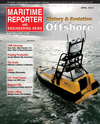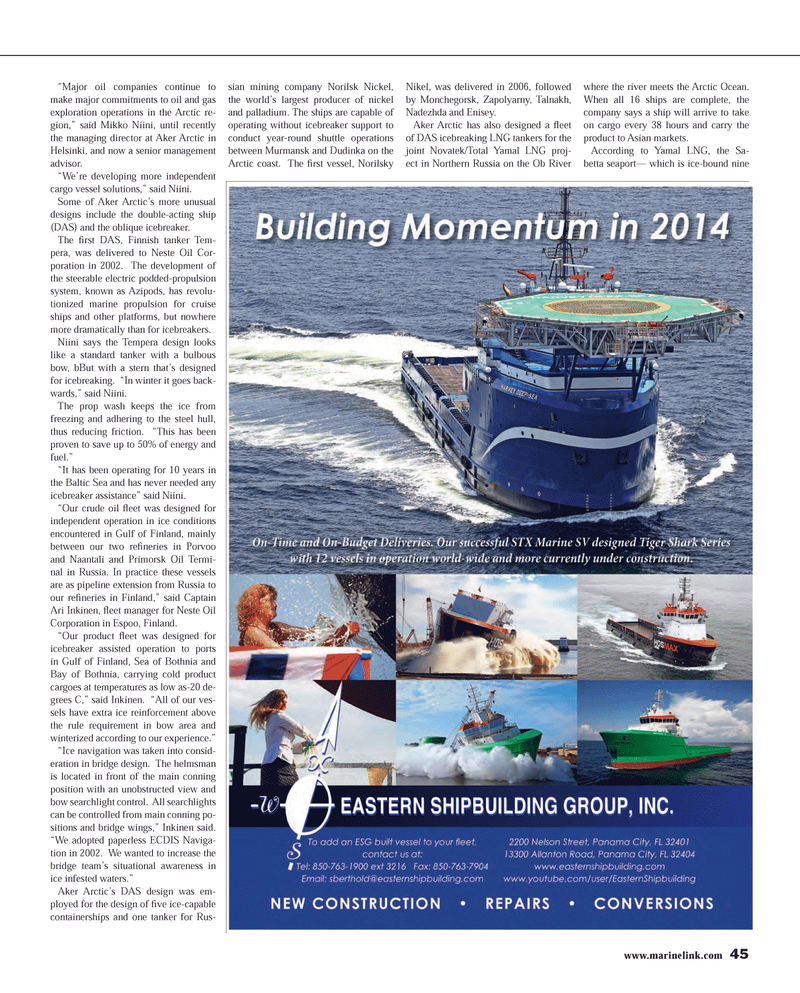
Page 45: of Maritime Reporter Magazine (April 2014)
Offshore Edition
Read this page in Pdf, Flash or Html5 edition of April 2014 Maritime Reporter Magazine
www.marinelink.com 45?Major oil companies continue to make major commitments to oil and gas exploration operations in the Arctic re- gion,? said Mikko Niini, until recently the managing director at Aker Arctic in Helsinki, and now a senior management advisor. ?We?re developing more independent cargo vessel solutions,? said Niini. Some of Aker Arctic?s more unusual designs include the double-acting ship (DAS) and the oblique icebreaker. The Þ rst DAS, Finnish tanker Tem- pera, was delivered to Neste Oil Cor- poration in 2002. The development of the steerable electric podded-propulsion system, known as Azipods, has revolu- tionized marine propulsion for cruise ships and other platforms, but nowhere more dramatically than for icebreakers. Niini says the Tempera design looks like a standard tanker with a bulbous bow, bBut with a stern that?s designed for icebreaking. ?In winter it goes back-wards,? said Niini. The prop wash keeps the ice from freezing and adhering to the steel hull, thus reducing friction. ?This has been proven to save up to 50% of energy and fuel.??It has been operating for 10 years in the Baltic Sea and has never needed any icebreaker assistance? said Niini. ?Our crude oil ß eet was designed for independent operation in ice conditions encountered in Gulf of Finland, mainly between our two reÞ neries in Porvoo and Naantali and Primorsk Oil Termi- nal in Russia. In practice these vessels are as pipeline extension from Russia to our reÞ neries in Finland,? said Captain Ari Inkinen, ß eet manager for Neste Oil Corporation in Espoo, Finland.?Our product ß eet was designed for icebreaker assisted operation to ports in Gulf of Finland, Sea of Bothnia and Bay of Bothnia, carrying cold product cargoes at temperatures as low as-20 de- grees C,? said Inkinen. ?All of our ves-sels have extra ice reinforcement above the rule requirement in bow area and winterized according to our experience.??Ice navigation was taken into consid-eration in bridge design. The helmsman is located in front of the main conning position with an unobstructed view and bow searchlight control. All searchlights can be controlled from main conning po-sitions and bridge wings,? Inkinen said. ?We adopted paperless ECDIS Naviga- tion in 2002. We wanted to increase the bridge team?s situational awareness in ice infested waters.?Aker Arctic?s DAS design was em- ployed for the design of Þ ve ice-capable containerships and one tanker for Rus-sian mining company Norilsk Nickel, the world?s largest producer of nickel and palladium. The ships are capable of operating without icebreaker support to conduct year-round shuttle operations between Murmansk and Dudinka on the Arctic coast. The Þ rst vessel, Norilsky Nikel, was delivered in 2006, followed by Monchegorsk, Zapolyarny, Talnakh, Nadezhda and Enisey. Aker Arctic has also designed a ß eet of DAS icebreaking LNG tankers for the joint Novatek/Total Yamal LNG proj- ect in Northern Russia on the Ob River where the river meets the Arctic Ocean. When all 16 ships are complete, the company says a ship will arrive to take on cargo every 38 hours and carry the product to Asian markets. According to Yamal LNG, the Sa- betta seaport? which is ice-bound nine MR #4 (42-49).indd 45MR #4 (42-49).indd 454/7/2014 4:03:05 PM4/7/2014 4:03:05 PM

 44
44

 46
46
